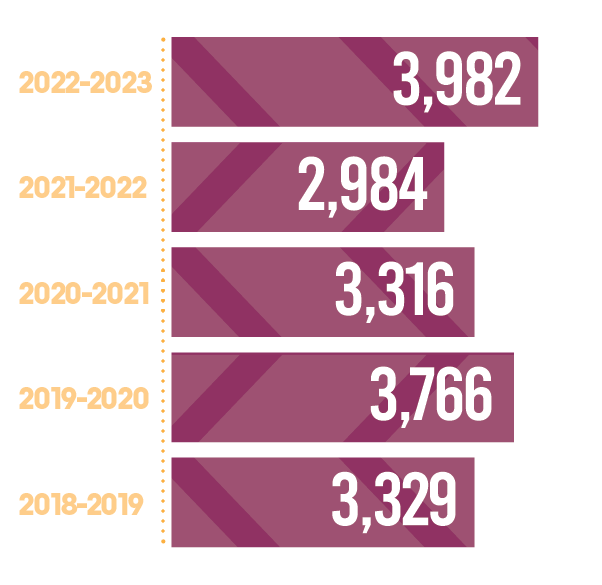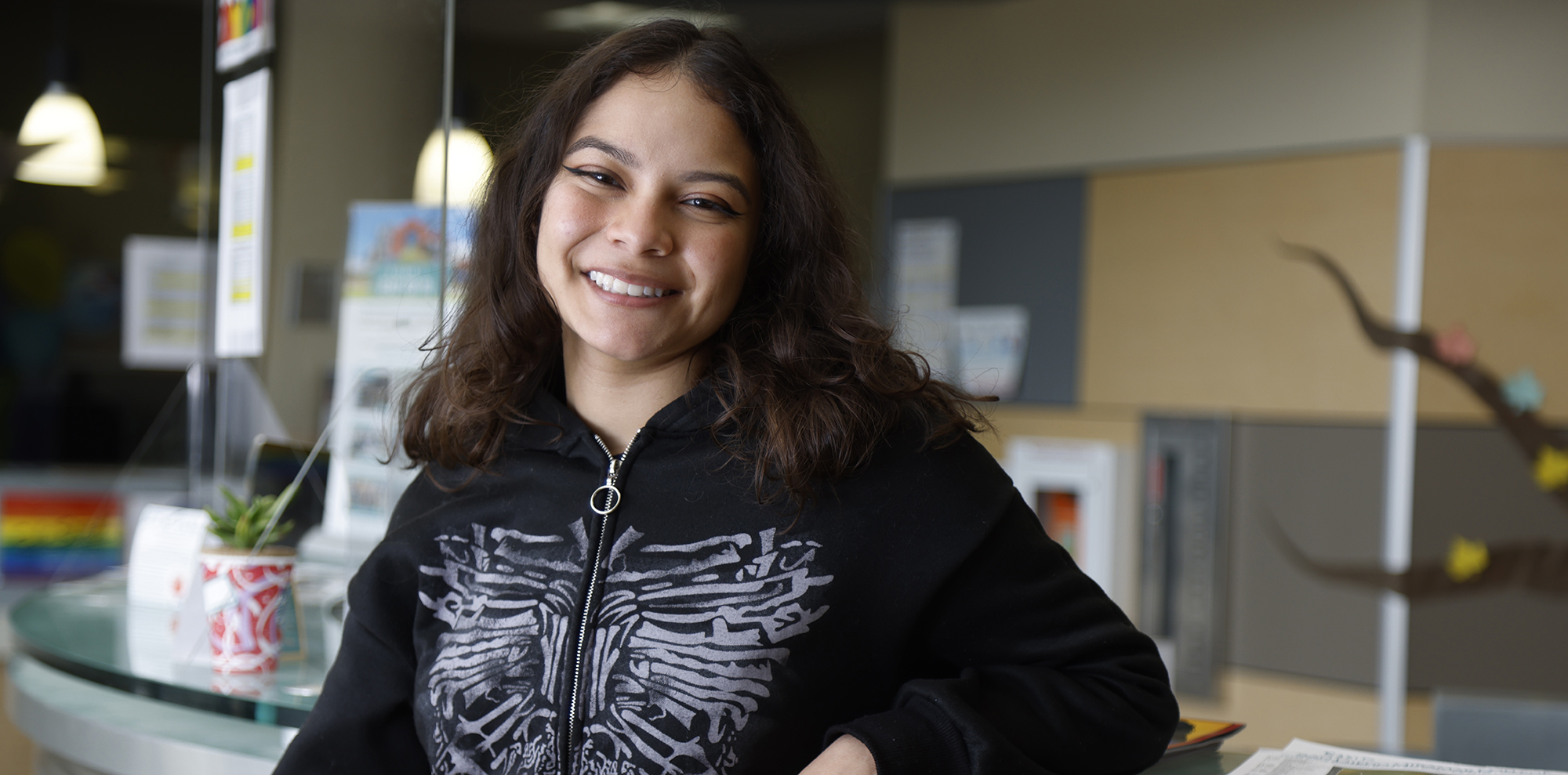
“I was kind of hesitant,” Hinojosa said. “I wasn’t a straight-A student, so I didn’t know if I could handle college. I pushed myself and my parents also pushed me and told me I was capable. I gave it a shot and it worked out.”
Hinojosa took two English and two math classes in her senior year at high school, then began attending Miramar College after she graduated in 2020.
“I was thinking about going to Miramar, but taking those classes ensured it,” she said. “I came here because I knew I had a grasp of what the classes will be like.”
Hinojosa, who is now also a Peer Mentor at Miramar College, is one of the thousands of students from the SDCCD who have benefited from a decade-long partnership between the K-12 San Diego Unified School District and the San Diego Community College District. Because of the strong relationship between the two districts, high school students have numerous opportunities to earn college credit even before they graduate from high school.
Amertah Perman, dean of Career Education and Workforce Development at the SDCCD, said every San Diego Unified School District high school offers some way that its students can earn college credit through a partnership with the SDCCD’s credit colleges, San Diego City, Mesa, and Miramar colleges.
“It’s a long-term goal of ours to ensure that all high school students have an opportunity
to graduate with some type of postsecondary certificate,” she said.
Three primary avenues exist for high school students to earn credit from a SDCCD college.
One method is through classes that are taught by college faculty on high school campuses
through a program known as College and Career Access Pathways (CCAP). Almost 4,000
San Diego Unified School District high school students took CCAP courses in 2022-2023,
averaging about 8 to 9 credit units, or three courses, before they graduated.
Learn more about
Dual Enrollment
Although students as young as ninth grade are sometimes able to take college classes, most of the students enrolled are juniors or seniors in high school. The courses are offered for free during the school day, and the classes cover a wide range, from English and math to courses in business, Black studies, political science, health, and many others.
Genevieve Esguerra, dean of Outreach and Enrollment Services at City College, said some high school students, particularly those from families without college graduates, might not have considered attending college.
“Sometimes the idea of going to college is not even on their radar,” Esguerra said. “The ability to offer a college class during the high school time helps to change a student’s perception on what it means to be a college student and what they can achieve.”
At the most recent Joint Board Meeting in March at the Logan Memorial Educational Complex, it was revealed that in their first year as college students at City, Mesa, or Miramar, former CCAP students had higher success rates in their first year as college students (77% of enrollments earning a passing grade) than first-time students who did not participate in CCAP ( 69%). Additionally, students are shown to earn more units (16.8 vs. 11.3), are more likely to persist to a second year of college (66% vs. 50%), and are more likely to earn a degree for transfer (11% vs. 3%).
An additional 2,900 high school students in the 2021-2022 school year were able to
receive college credit for career education courses they took in high school by passing
a college-level exam. Almost a third of those students enrolled at City, Mesa, or
Miramar college after they graduated from high school.
The courses eligible for college credit focus on career pathways that align the high
school and college courses, said Sarah Vielma, director of the College, Career, and
Technical Education department at San Diego Unified School District. High school teachers
work with college faculty to review the courses in fields as diverse as health, culinary
arts, or digital photography so that students who pass an exam can earn college credit.
More than 1,000 students took advantage of a third option allowing high school students to enroll in courses at the colleges. About 86% of those students were successful in their courses.
To encourage students to consider college in their future, SDCCD representatives are reaching out to San Diego Unified School District students as young as 1st- and 2nd-graders, said Luke Menchaca, dean of Outreach and Student Affairs.
“It doesn’t just happen after they graduate from high school. We’re connecting with them at an early age,” he said. “We’re invested in them so we want to continue that investment, and that investment impacts the community.”
Some students had not considered college for financial reasons, so an important part of outreach efforts is informing them about the San Diego Promise program, which offers two years of free tuition, as well as assistance with book costs and other programs, at the SDCCD’s credit colleges. At the start of the 2022-2023 academic year, the Promise program reached a new enrollment record with 2,349 students — and 1,076 of those students came from San Diego Unified School District schools.
Perman said the benefits to students are possible because of the close collaboration between the two districts. The efforts begin at the governing board level, where the two boards meet annually to set goals, and the partnership is strengthened with regular meetings between college and high school leaders to hammer out the details.
The original intent of the joint venture was to increase the number of underrepresented students in higher education, but the agreement has expanded so that all students benefit, said Jennifer Roberson, senior director of the Office of Graduation at San Diego Unified School District.
“It really is a partnership,” Roberson said. “Jointly, we have created a seamless process for students to enroll in courses and have ongoing goals and metrics for increasing access and enrollment.”
The logistics of coordinating high school and college classes can be complex, but the reward of having students realize they can succeed in college courses make the effort worthwhile, said Sonny Nguyen, dean of Enrollment Services at Miramar College.
“It’s quite the process, but ultimately it does benefit students,” he said. “We’re giving students the opportunity to access college classes.”
The college classes that Hinojosa took when she was in high school gave her more confidence when she began attending Miramar College. She’s planning to transfer to a four-year university to pursue a psychology degree, with a career goal of working as a mental health counselor.
She said she would encourage any high school student who is considering taking a college class to do so.
“Try something new even if you think you won’t be capable of doing it,” she said. “It can be hard, but challenging yourself can bring out the best in you.”
